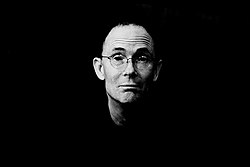 William Gibson in 2007 | |
| Novels ↙ | 12 |
|---|---|
| Articles ↙ | 25 |
| Stories ↙ | 21 |
| Collections ↙ | 1 |
| Scripts ↙ | 6 |
| Screen appearances ↙ | 13 |
| Forewords, introductions and afterwords ↙ | 16 |
| Miscellanea ↙ | 9 |
| References and footnotes | |
The works of William Gibson encompass literature, journalism, acting, recitation, and performance art. Primarily renowned as a novelist and short fiction writer in the cyberpunk milieu, Gibson invented the metaphor of cyberspace in "Burning Chrome" (1982) and emerged from obscurity in 1984 with the publication of his debut novel Neuromancer . [1] [2] Gibson's early short fiction is recognized as cyberpunk's finest work, [3] effectively renovating the science fiction genre which had been hitherto considered widely insignificant. [4]
Contents
- Novels
- Short fiction
- Collected
- Uncollected
- Excerpted
- Screenplays
- Unrealized
- Comics
- Non-fiction
- Articles
- Forewords, introductions and afterwords
- Screen appearances
- Acting appearances
- Documentaries
- Television appearances
- Miscellanea
- References
- External links
At the turn of the 1990s, after the completion of his Sprawl trilogy of novels, Gibson contributed the text to a number of performance art pieces and exhibitions, [2] [5] [6] as well as writing lyrics for musicians Yellow Magic Orchestra and Debbie Harry. [7] [8] He wrote the critically acclaimed artist's book Agrippa (a book of the dead) in 1992 before[ citation needed ] co-authoring The Difference Engine , an alternate history novel that would become a central work of the steampunk genre. [9] He then spent an unfruitful period as a Hollywood screenwriter, with few of his projects seeing the light of day and those that did being critically unsuccessful. [10]
Although he had largely abandoned short fiction by the mid-1990s, Gibson returned to writing novels, completing his second trilogy, the Bridge trilogy at the close of the millennium. After writing two episodes of the television series The X-Files around this time, Gibson was featured as the subject of a documentary film, No Maps for These Territories , in 2000. [11] Gibson has been invited to address the National Academy of Sciences (1993) and the Directors Guild of America (2003) and has had a plethora of articles published in outlets such as Wired , Rolling Stone and The New York Times . His third trilogy of novels, Pattern Recognition (2003), Spook Country (2007) and Zero History (2010) have put Gibson's work onto mainstream bestseller lists for the first time. [12]





